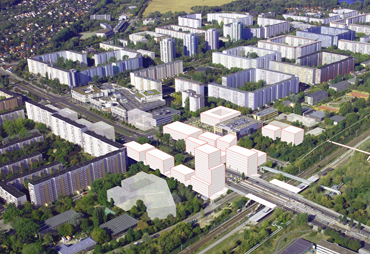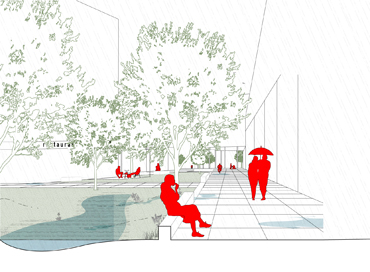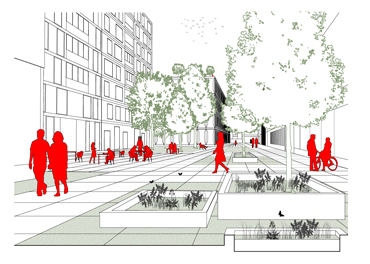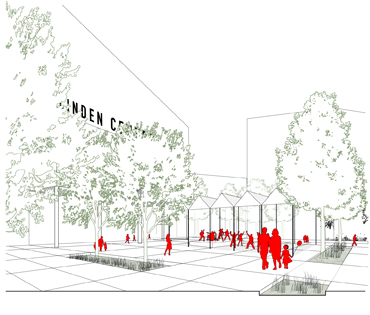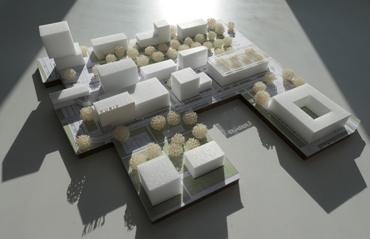morePlatz
architecture / urbanism / art / office / publications / contact deutsch
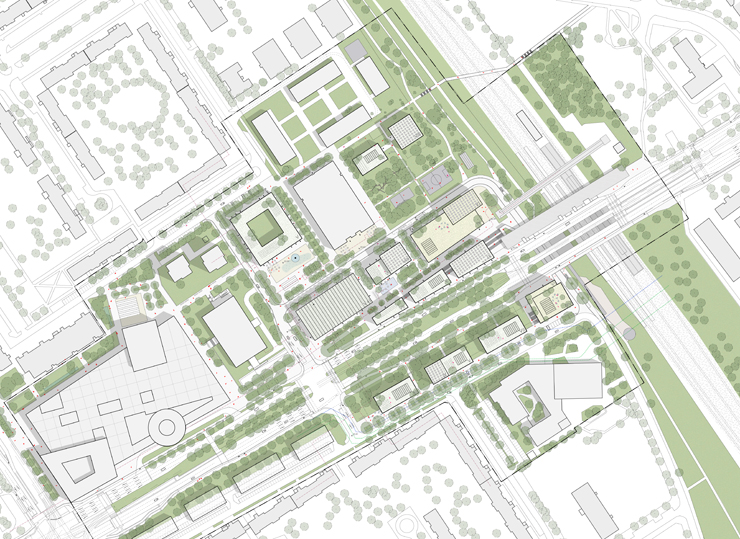
|
Lively district center The Falkenburger Chaussee is a strong main axis, which currently only represents infrastructure, although it has the potential to become a strong backbone for the district. In order to achieve this, the road has to be integrated into the urban fabric of the quarter in order to overcome the separation of functions established in the area. |
The green corridor along the railway connects the area of ??the urban center with the surrounding open spaces and functions as a district park that is used for recreation and sport. There are also many educational and sports facilities in this area. The design strengthens this green connection and adds sports and recreational elements. The KUBIZ is also located along this axis. The central area will be integrated into the existing urban fabric, in which continuous connections are maintained and strengthened. A good mix of living and working is essential for a lively quarter, whereby the ground floor zone in particular is activated for public use and the upper floors are used for living. The collective functions of living, such as playgrounds and bicycle parking spaces, are provided at the residential buildings. The roofs are activated for residents' gardens where possible. The vertical mix helps to organize the transitions from public to private spaces well and clearly. The core functions (HUB, cultural center ‚KUBIZ') with high frequency and importance for the center are optimally arranged. The KUBIZ, with its social and cultural significance, is a central component of this, at the same time it is located directly on the green open space axis along the railway and in the immediate vicinity of the hub and train station.
|
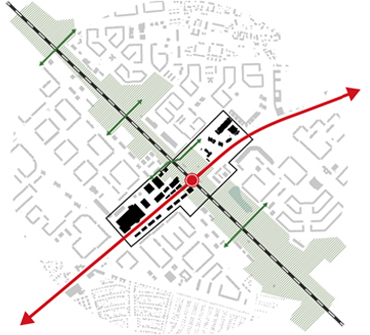 |
|
|
The KUBIZ lies at the intersection where the networks of public transport, the open spaces and the functions of the center come together. It contains a large, publicly accessible roof garden, which enables gastronomy and events such as theater or cinema. The neighborhood garage / mobility hub is optimally connected at the entrance to the area. In accordance with the excellent location, the ground floor is largely used for district functions, and most of the parking spaces are located on the upper floors. Disabled-accessible and 'car-sharing' parking spaces are also arranged on the ground floor. The day-care center is located in the immediate vicinity of the schools, but in a quiet and sheltered location, which is connected to the open space axis via a small park. Other sports and play options are also suggested here. |
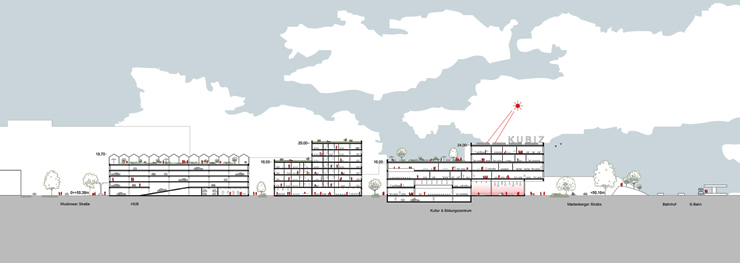
One center - several characters The Falkenburger Chaussee becomes a city avenue. Development along the slope offers new addresses and functions on the street. Additional crossing options for pedestrians make the Chaussee a part of the usable street space in the quarter. New tree planting gives the road a greener, urban character. The central route from Zingsterstraße via Prerowerplatz - Brunnenplatz - Kulturplatz am KUBIZ to the train station connects active and lively spaces and forms an urban promenade. |
|
The Prerower Platz acts as city square. We level the differences in height in the square and install a new roof that allows different uses and users (concert, Christmas market, festival, theater). The fountain square becomes a water square with space for terraces. Children can play here, while parents enjoy the sun on the terrace, and cinema-goers can find gastronomic offers before or after the film. The Wartenbergerstrasse continues to the KUBIZ and ends in the Kulturplatz, where the main entrance to the KUBIZ is. The center route continues to the covered access to the train station. The 'street of the district heating pipelines' will be a quiet and green street with offices, entrées of houses and studios. The green is planted in troughs on semi-paved surfaces and can easily be cleared aside with a forklift for repairs to the lines. Halfway down this street, the building jumps back, creating a secluded square. A perfect place for a quiet terrace in the sun. |
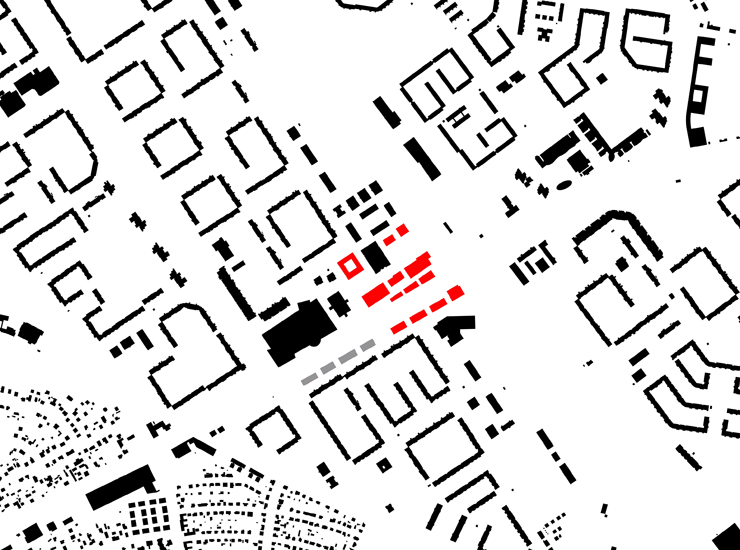
|
|
The height development of the buildings with 5-8 storeys corresponds to the small-scale development - in addition, an accent is proposed on the bridge that reaches a height of almost 50m. The variable layout of the building plots enables different actors in urban development to participate in the development of the area. (e.g. institutional developers, cooperatives, assemblies, etc.) The Falkenburger Chaussee becomes a city avenue. From the intersection Wustrowerstrasse the slope is replaced by a pedestal that accompanies the street, which enables separate and wider foot- and cycle paths and offers new addresses and functions along the street through the development. The development conveys the difference in level between the Chaussee and the residential areas. It is accessible on both levels, and some parking garages (car, bicycle) are also integrated in the base. This reduces the oversize of the street profile to a scale compatible with the neighborhood. |
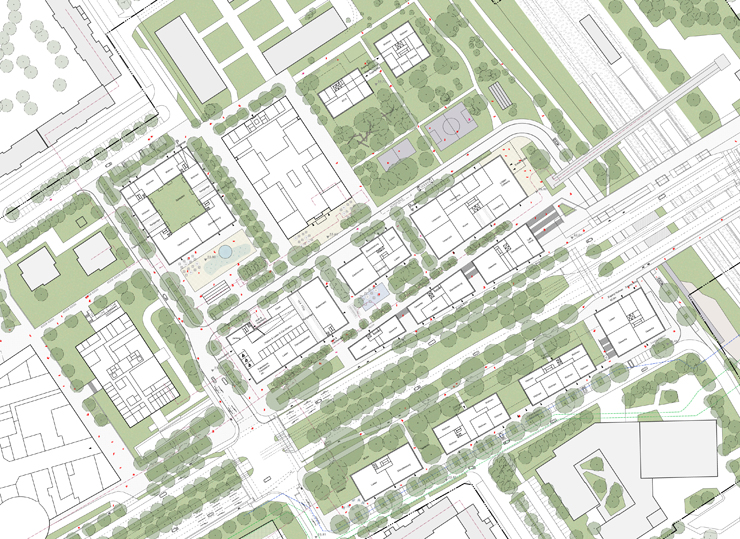
Additional crossings for pedestrians transform the Chaussee into an usable street space in the quarter. (For this purpose, the water pressure lines are moved). In the area of ??the train station, a widened, spacious access area will be created on the street, and from there the avenue will continue to the north. In this way, the barrier effect of the railway line can be overcome. New trees are planted to give the road a greener, urban character. New mobility
|
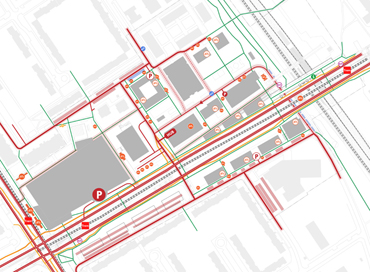 |
|
|
In order to minimize passage and parking traffic, the mobility hub will be centrally located at the entrance to the area on Wustrowerstrasse. As a result, a large proportion of the target traffic is quasi 'sucked in', while the remaining traffic areas are only used by pick-up and delivery traffic. In order to upgrade the S-Bahn station as a hub, the accessibility with wider paths is improved, and a better quality of stay is created in the area of ??the station itself through roofing and service offers. Healthy urban environment |
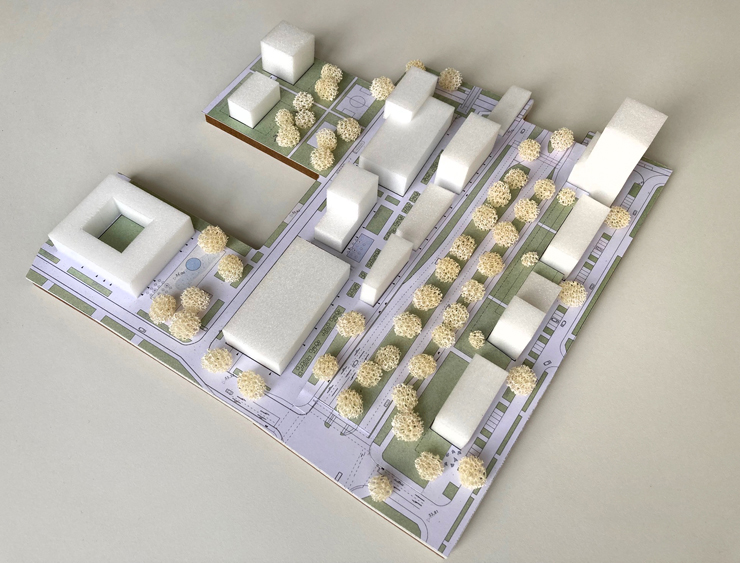
The optimal mix of tree species and other planting (ground cover, shrubs) is based on the ecological value. Facades can be greened wherever possible, e.g. the facades of the HUB. The green in the community center forms an urban biotope that extends over the public space and the roofs and is part of the ecological concept of the quarter - nature-inclusive building. The new center is to be built according to climate-adaptive criteria. |
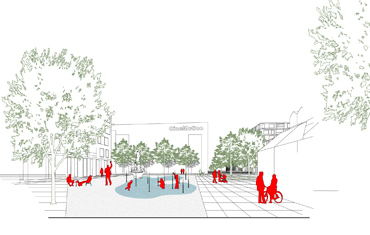 |
|
|
The actively used roof landscape provides collective added value for the area. The development should, if possible, be entirely made of wood or hybrid constructions, and thus be another pilot project for circular, sustainable urban development. The New Urban Center is designed as a neighborhood that invites movement. The short distances are designed for cyclists and pedestrians, the residential areas are well networked with the nearby areas for sports and games in the green railway park. competition 2nd phase, honorable mention |

